As an Amazon Associate I earn from qualifying purchases.
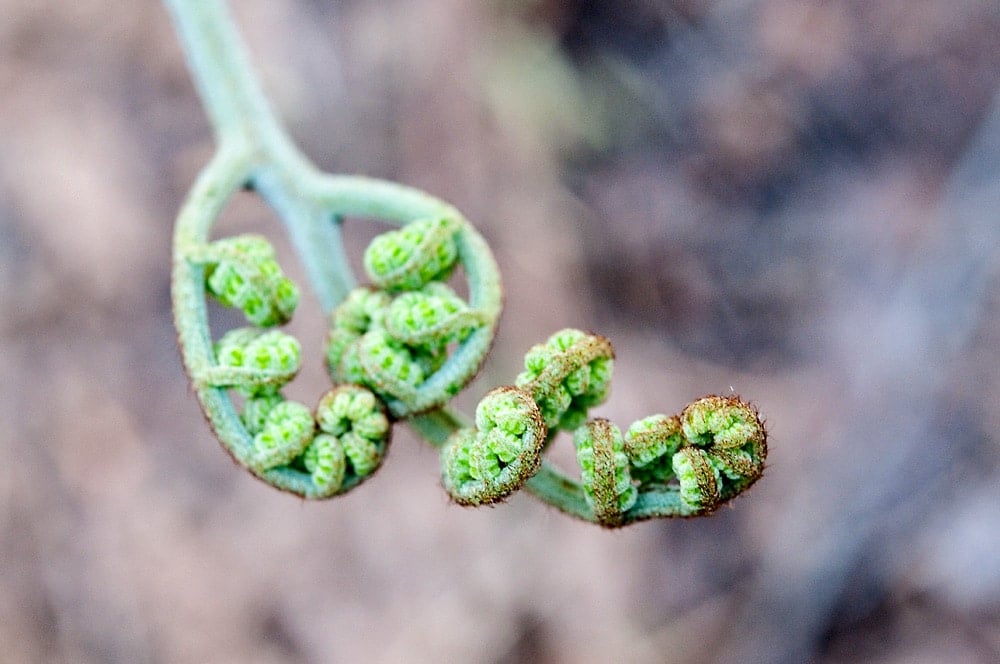
I eat a known carcinogen every spring. But then again, chances are, so do you.
Few wild plants are as polarizing as bracken fern, Pteridium aquilinum. It is a global species, living everywhere but the harshest deserts and the coldest tundra. Here in California, it is ubiquitous. I find its fiddleheads — odd looking fiddleheads, like an eagle’s clenched talon — in Point Reyes as early as late February and as late as mid-June in the High Sierra.
That means if you wanted, you could eat bracken fern fiddleheads for four straight months here in California. You could, but you shouldn’t.
Bracken fern does indeed contain a carcinogen, that much is clear. It also contains an enzyme that makes Vitamin B1 less available to the body, so chronic consumption of bracken can lead to nastiness like beriberi. I’ve spent a lot of time over the years reading scientific papers with names like “Induction of Tumors in ACI Rats Given a Diet Containing Ptaquiloside, a Bracken Carcinogen.”
Breezy reading, this. But the slog has been worth it, if only because I refuse to trust the internet and my fellow foraging writers outright. Bracken is so controversial you will see them writing statements ranging from “eat it as much as you want, it’s fine,” to “never, ever, ever eat bracken, raw or cooked.”
And like most black-and-white statements, both are wrong.
After a pretty exhaustive — and exhausting — survey of the literature, it seems pretty clear that a typical forager’s diet of bracken fiddleheads, blanched and sauteed with lots of butter (or whatever) is perfectly safe. Before you start shouting at me, let me explain.
The primary villain lurking within bracken fern is a substance called ptaquiloside. It is, by all accounts, nasty stuff. And bracken fiddleheads are packed with it, up to 0.8 percent by dry weight, according to some studies. But therein lies the first caveat: A raft of other studies shows that ptaquiloside levels vary wildly in bracken stands. Some in New Zealand were even found with none of the stuff at all. So you really have no idea how much — if any — of the carcinogen lies within your pretty fiddlehead.
It is abundantly clear, however, that if you eat raw bracken fiddleheads in the woods you will probably ingest ptaquiloside. And that’s not good eats.
But ptaquiloside has three properties that are of interest to us:
- First, it is not actually a carcinogen, according to the latest research. But it is volatile, and likes to react in alkaline environments to create what is now suspected of being the true carcinogen, a substance called dienone. This is why drinking milk from animals that have been eating a lot of fiddlehead fronds is a very bad idea; milk, and the healthy stomach of a ruminant, is basic enough to cause the ptaquiloside to transform into dienone.
- Second, ptaquiloside is water soluble. That means if you soak bracken fiddleheads in cool water (cool to keep them crunchy), and change that water every so often, you will greatly reduce the level of this nasty substance in the fiddlehead; the Japanese often eat bracken this way.
- Third, ptaquiloside is notoriously volatile at normal temperatures. The pure stuff degenerates at room temperature, which is why the scientists doing the rat studies store their ptaquiloside at -20° Celsius. Once exposed to boiling temperatures, the carcinogen denatures almost completely. Salt increases this effect.
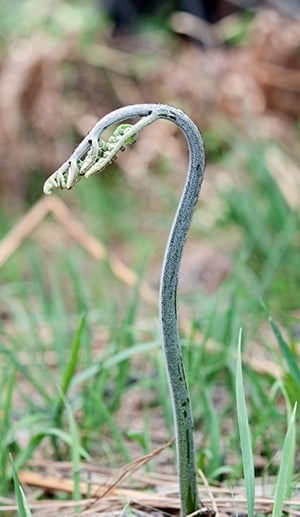
Virtually all the data on the subject link most human health problems associated with bracken fern to exposure to contaminated milk from animals eating bracken, contaminated groundwater near bracken stands, and, in some cases, long-term exposure to bracken spores; so if your yard is covered in bracken fern, you might want to dig most of it up.
What all this means is that a very normal cooking process for fiddleheads — blanching in salty water, then shocking in ice water, then sauteeing — renders the fiddlehead close to harmless.
Note that I say “close to harmless.” Even though most of the research out there suggests that normal human methods of eating bracken, which, incidentally, has been eaten by cultures across the globe since prehistory, denature or render harmless what ptaquiloside exists in a bracken fiddlehead, there is one nagging piece of data out there: There is an apparent link between chronic consumption of bracken and an increased level of throat and gastric cancers in the populations of Korea, Japan and parts of China. Bracken is widely eaten in Korea, Japan and parts of China. And when I mean “widely,” I mean almost every day in some cases. Bracken (gosari) is a classic part of bibimbap, one of the most famous Korean dishes there is.
Most of the research on this has been done by Japanese and Koreans, searching for clues as to why they seem to have high rates of throat and stomach cancer. Apparently there are a kaleidoscope of reasons, and habitual bracken-eating is among them. Like anything, ptaquiloside’s poison is in the dose. According to my reading of the research, the body apparently can process out only so much of the stuff, and constant eating of bracken puts too much in the system, and that’s what causes cancer.
I know what you are saying. Why even mess with this crazy bracken thing? Why even put myself at risk?
Several reasons. First, bracken tastes wonderful, like asparagus, almonds and Tuscan black kale all rolled into one. Second, eating bracken is akin to drinking alcohol: Done responsibly, it is enjoyable and perfectly safe. But just as you would not rationally decide to drink a case of beer every day for a month, you would not rationally choose to eat a big plate of bracken ferns every day during the fiddlehead season.
I choose to eat bracken fiddleheads. How often? Maybe a half-dozen times a year. Eat them once and you will see what all the fuss is about, and make your own decision. Just remember your Aristotle: All Things in Moderation.
If you do pick your own bracken fiddleheads, choose those that are not fully extended. You want them either in the horseshoe bend or at least tightly closed. Remember, the eagle’s talon should be clenched, not open. Do not eat them once their fronds unfurl.
Buttered Bracken Fern
Ingredients
- 3/4 to 1 pound young bracken fiddleheads
- Salt
- 3 tablespoons truffle butter, or regular butter
Instructions
- Trim the bracken fiddleheads to an even length. Bring a large pot of water to a boil and add enough salt to make it taste like the sea. Fill a large bowl with ice water. Boil the bracken for 2 minutes, then plunge into the ice water. let them sit in the water for 45 minutes to 1 hour. Discard the water. Pat dry.
- Heat half the truffle butter in a large saute pan over medium-high heat. Saute the fiddleheads for 4 to 5 minutes, flipping them from time to time. Sprinkle some salt over them. Turn off the heat and add the remaining butter. Swirl to coat the fiddleheads with the butter as it melts. Eat at once.
Nutrition information is automatically calculated, so should only be used as an approximation.
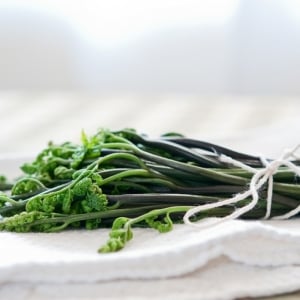
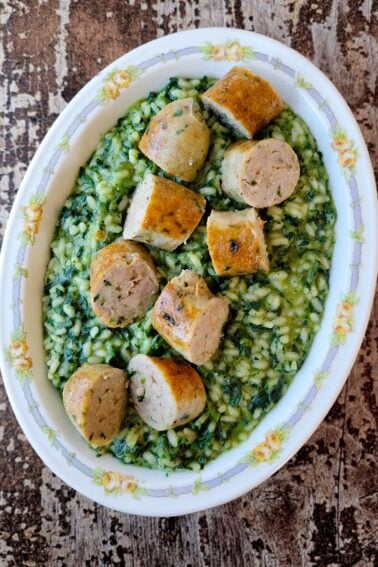
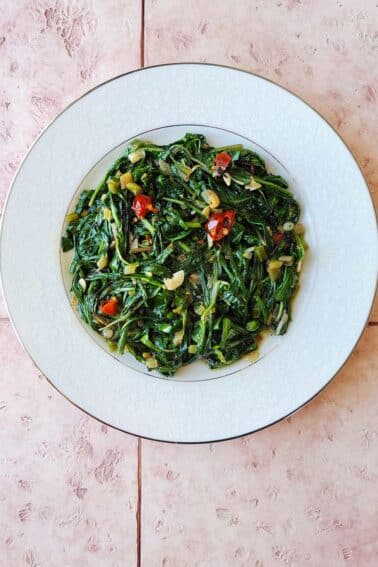

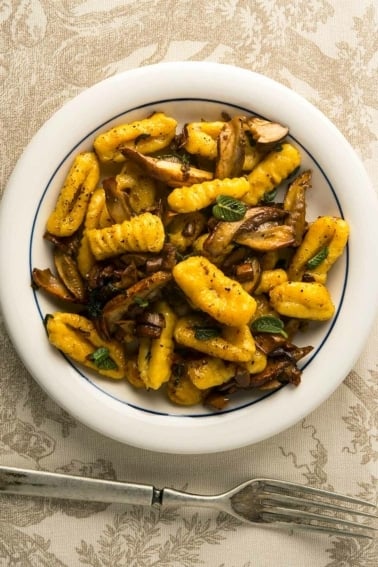
Controversy is driven from a paucity of knowledge
If boiling is done in alkali hard water(rich in Calcium Carbonate) dienone will be produced and soaking in cold will not leach it out.Last cook with butter could still retain some dienone which is very fat soluble and so will not all evaporate away. Principle toxic component only Ptaquiloside there are others eg Pterosin C.
The only definitive answer is testing cooked product for presence of toxic compounds .
Hi, Hank,
For many years, I have been wanting to buy to eat in my bibimbap and in Yukgaejang soup. When i typed Pteridium aquilinum, it says Eagle Fern, Eastern Bracken fern. And, another search shows as Western Fern and Southeastern fern. Have you tasted other edible ferns, such as Royal fern, Ostrich fern? Also, Is Fiddleheads or fiddlehead greens totally separate fern of its own kind? Too confusing ! Please help me to find the right fern. Thanks for reading.
I’ve eaten “brake greens” (bracken fiddleheads) since I was a kid. My great Aunt always had those, dandelion greens, young milkweed, etc., early every spring here in Maine. It comes before asparagus and is generally one of the first spring “greens.” We don’t have ostrich ferns on the property, so no classic “fiddleheads,” but brake greens are good, too.
Great article. Just not confident to pick them myself. They eat this widely in Malaysia, everyday, everywhere. Not sure if throat and stomach cancers rate are high; would it be a different variety of fern?
It’s not bibimbap without gosari! I have it dried on hand all the time, but I’m thinking about growing some for fun. I don’t make bibimbap often – I live alone and it’s a hassle to come up with all the right ingredients at he same time. But the bracken fern is what makes it classic. Great article, thanks!
Well, I’m trying bracken fiddleheads for lunch today, don’t have any truffle butter so going to use garlic butter, I’ve spent over $10,000 over the last 30 years trying to get rid of bracken fern on my farm as it kills my cows if they eat to much of it, so I’m delighted to find that I can actually eat the stuff, thank you for all your information on the bracken fern, best I’ve found so far.
Brenda: Where are you? Australia? Bracken is not edible in the Northern Hemisphere right now. It’s only edible as a young fiddlehead.
Ostrich fern and royal fern are also edible and available where I am in Michigan. They are larger and often what is sold as fiddle head ferns around here. Our Korean foraging leader collects bracken fern and serves bibimbop ever time she does a foraging class. She always blanches the bracken fern before eating it.
Do we have anything else here in CA that is edible other than Bracken and Lady Fern (and the below)? I cannot locate Bracken or Lady Fern in the woods behind my house in South Bay CA. Unless I go to a park probably.
I located and identified Adiantum jordanii (CA Maidenhair). I can use rhizomes for tea, and the stems for basketweaving, but no thanks. I have a ton of Coastal Wood fern (Dryopteris arguta; again, rhizome only for tea) and a bit of Polypodium californicum (CA polybpody) which I did eat some fiddleheads from, very small though. I also identified Pentagramma triangularis (golden back fern I think it is also called) but that’s useless to me foodwise. I can find no Lady Fern, which is a bummer. I am up to my ears in Chickweed, Miner’s lettuce and stinging nettle right now, but my fiddleheads are not to be found. I think it is quite possible that my neighbor has an enormous red-haired looking fiddlehead that I cannot identify but I doubt he would appreciate me hacking it off and cooking it up 😉 I love your site : )
Marianne: No, not to my knowledge. Only those two ferns are edible. Sorry.
Thank you for all the great information.
The Iceman found in Northern Italy, who lived around 3300 BC, ate bracken.
From the NY Times: “The Copper Age menu was well balanced, consisting of ibex meat, smoked or raw; einkorn wheat (an early domesticated variety), possibly in the form of bread; some sort of fat, which might have been from bacon or cheese; and bracken, a common fern.”
Hi,
First, thanks! I have tried bracken, this year, for the first time, thanks to the detailed instructions to using it safely. One thing puzzles me in your explanation, however. You state: “… ptaquiloside …likes to react in alkaline environments to create what is now suspected of being the true carcinogen, a substance called dienone.” but further down the page you suggest that baking soda will help “detoxify” the bracken shoots. Umm… shouldn’t we avoid baking soda but perhaps use a dash of vinegar? Your thoughts on this?
Jacqui: Good catch! I updated this article last year; it was originally written in 2009. Will adjust the article to reflect that. Thanks!
Hi,
Thanks for doing the thorough research for us. I live in the Point Reyes area and am enjoying the bounty you spoke of right now.
Do you of any other edible ferns in the area that are as easy to identify. My friend recommended the sword fern but another said it was poisonous. Looking online it was hard to tell if sword ferns were one species or just a local name. Please demystify!
Whimzerd: Local native groups ate the rhizomes of sword fern, not the fiddleheads. Not sure exactly how they went about it, either.
Great article. I had eating bracken in the past and heard it was highly toxic. Here you answered my question re toxicity. I will now eat bracken again, but with moderation. It taste so good, I cannot turn my back on it 😉
Thank you so much! This just answered a bunch of questions that have cropped up for me over the years of eating Korean food and foraging…
I’m a Japanese. We enjoy this fear as well as fiddle head in Spring. We at first boil them in a pot with water and a table spoon of baking powder, then plunge them in cold water, let it sit more than hour. Then cook as you like. When I was a kid I thought this process is to get rid of some poison, but it seems like to get rid of bitterness. I noticed the western people doesn’t use baking soda.
Having lived in South Korea I was wondering if I could grow my own gosari and get my hands on some. I started with figuring out what it was called in English 😛 I have never heard anything in relation to it being a carcinogen because I was introduced to it with regards to healthy eating/eating from nature. Its all about eating food within limits.
Thank you for the information on how to harvest it and here is the recipe I am goin to use 😛
https://www.youtube.com/watch?v=6QQ67F8y2b8
I am half korean, and have been picking and drying these fern vegatbles since I was very young, I am now 51. My mother taught me about this vegatable which is a Korean delicacy called Gosari. We would boil them, wash them, and sautee them with soy sauce, delicious. We would eat them most of the early spring and dry the rest for the year. My mother is now 84, and her sisters are in their 90’s, I don’t believe the Gosari has harmed anyone.
Science , food, wildings and foragables, loved It Hank, THANKS
Great info. I’ve known of fiddle heads for awhile but I also know there’s more than one kind of fern out there. So, I’ve been wondering how to identify the ones I can harvest. Or can they all be eaten?
Hi Hank!
Really love this site.
I’m wondering if you have any thoughts on putting together a dish with Bracken Fern and Morels – both are popping in my yard and I like your ethos of pairing up ingredients from the same area/ecosystem (“Cooking With a Sense of Place” 10/28/15).
Thanks!
Brett